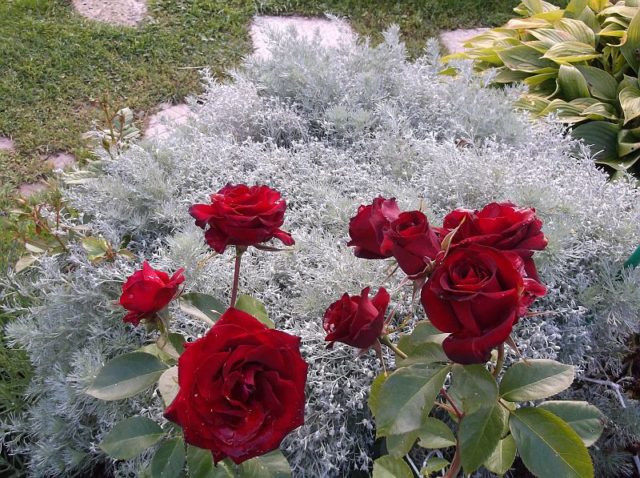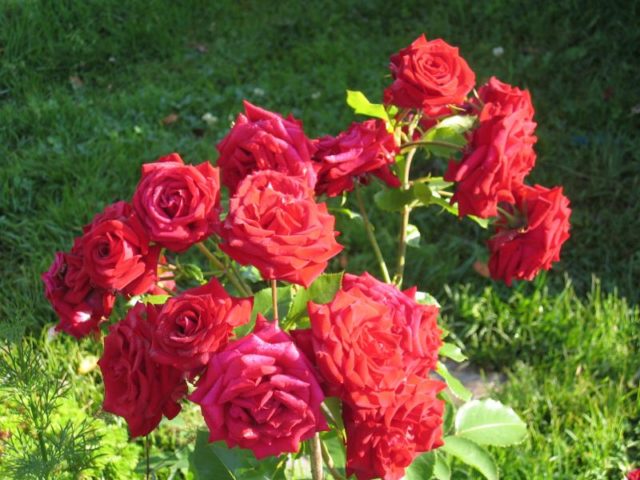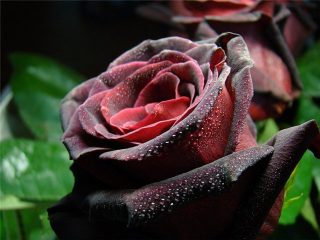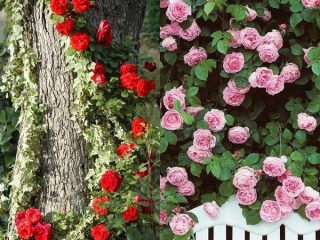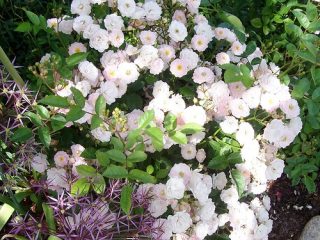Content
Rosa Niccolo Paganini is a popular medium-sized floribunda variety. The plant is actively used for decorative purposes. A characteristic feature of the variety is long and very abundant flowering. At the same time, it needs proper care and compliance with basic agrotechnical standards.
History of selection
It is mistakenly believed that the rose Niccolo Paganini was bred in Denmark by the famous scientist Sven Poulsen. In fact, this breeder obtained many other species belonging to the floribunda group.
Floribunda rose Niccolo Paganini was bred in 1991. The variety was obtained from the French breeding company Meilland.
Description of the floribunda rose Niccolo Paganini and characteristics
The plant is a compact upright bush. The average height of the Niccolo Paganini rose is 80 cm. Under favorable conditions, adult specimens grow to 100-120 cm.
The width of the plant is 100 cm. The bushes are of medium spreading nature. During the flowering period, the shoots may bend under the weight of the buds, but do not break.Therefore, gartering or the use of supports is only required to maintain the correct shape.
The stems are covered with dark green bark, which by the end of summer may acquire a reddish tint. The bushes are medium leafy. The number of thorns is insignificant.
The leaves on the shoots are ovoid in shape with characteristic jagged edges. The plates are matte, dark green, with slight venation. They are located on legs of 2-3 pieces.
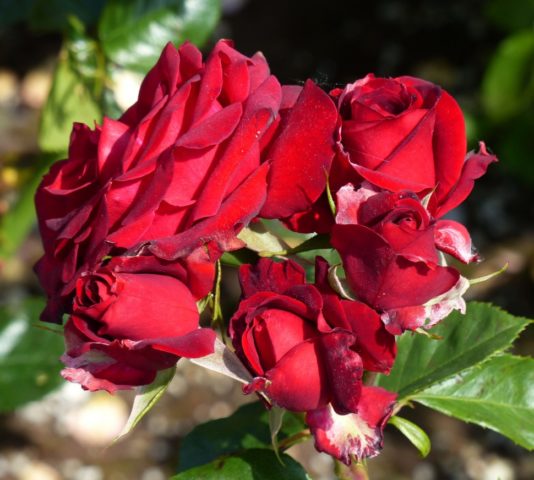
Niccolo Paganini roses bloom continuously throughout the summer
The budding period begins in May. The first flowers open in June. Less often, the deadline shifts to the end of the month. The buds bloom alternately, providing long flowering until the end of August.
In the early stages, the buds are cup-shaped. After 2-3 weeks they bloom completely and become flat, hemispherical. The color of the flowers is dark red. They are velvety with a lot of petals. Flowers are collected in brushes of 4-12 pieces each.
The Niccolo Paganini variety is characterized by high frost resistance. Adult plants can withstand short-term frosts down to -23 degrees. In the first year after planting in the ground, young bushes require shelter for the winter.
The plant is considered to be demanding on soil. It should be nutritious and fertile. The most important indicator is acidity. The optimal level for Niccolo Paganini roses is from 5.6 to 6.5 pH.
For good development, the bushes are planted in sunlit places. The Niccolo Paganini variety is drought-resistant. The flower normally tolerates a lack of liquid.Drying out can only be caused by a prolonged lack of watering.
The variety is adversely affected by waterlogging and stagnation of liquid in the roots. Against the background of such factors, diseases can develop. The plant exhibits moderate sensitivity to rust, powdery mildew and other fungal pathologies.
Advantages and disadvantages
Floribundas of the Niccolo Paganini variety have become widely known among gardeners. Rose has been repeatedly awarded prizes at international exhibitions and competitions.
Among the main advantages of the variety are:
- compactness of the bush;
- long and abundant flowering;
- high drought resistance;
- low sensitivity to frost;
- ease of care.
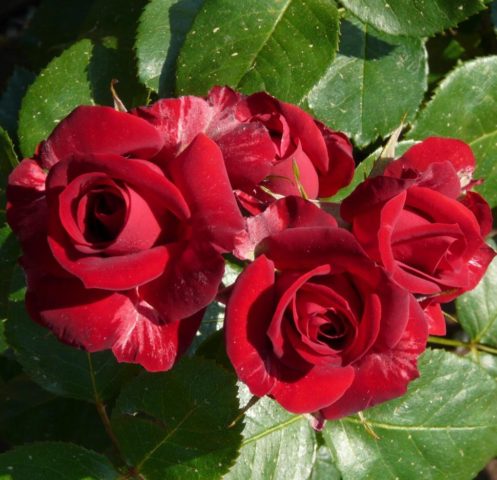
The petals of the presented plant do not fade due to bright sunlight
Despite a number of advantages, the Niccolo Paganini rose variety has several disadvantages. They can cause difficulties for inexperienced gardeners.
Main disadvantages:
- demands on soil composition;
- sensitivity to waterlogging;
- moderate susceptibility to some diseases.
The listed disadvantages compensate for the advantages of the variety. Compliance with agricultural technology eliminates complications when growing such a plant.
Reproduction methods
The main method is dividing the bush. The Niccolo Paganini variety tolerates this procedure well. The shoots of the rose are cut off and dug out of the soil. Several root shoots are produced from the mother bush.
Each shoot must be placed in open ground. An alternative option is to plant it in a container with a nutrient substrate, where the cutting will take root faster.
Niccolo Paganini roses are also propagated by cuttings. This method is applicable for adult bushes from 3 years old.

Rose cuttings are harvested in the spring during the budding period
Planting material is rooted in a container with soil. They are kept in a place with partial sunlight. Planting in the ground is carried out in the fall or next spring.
Growing and care
The Niccolo Paganini variety is planted in open, well-lit areas. It is advisable that the plant be slightly shaded during the midday hours.
The soil for roses should be nutritious, loose and light. The optimal composition includes peat, turf and leaf soil, and a small amount of river sand.
Planting stages:
- Dig a hole 60-70 cm deep.
- Place a drainage layer 25-30 cm thick.
- Fill in some of the soil mixture.
- Place the seedling in the hole.
- Spread the roots, placing them to the sides.
- Cover the seedling with soil and compact it.
- Water the plant.
After these procedures, the top layer of soil should be mulched with peat. Young plants are watered every week. A bush requires 10-15 liters of water.
Adult plants are watered as the soil dries. In summer this is done 2-3 times a week.
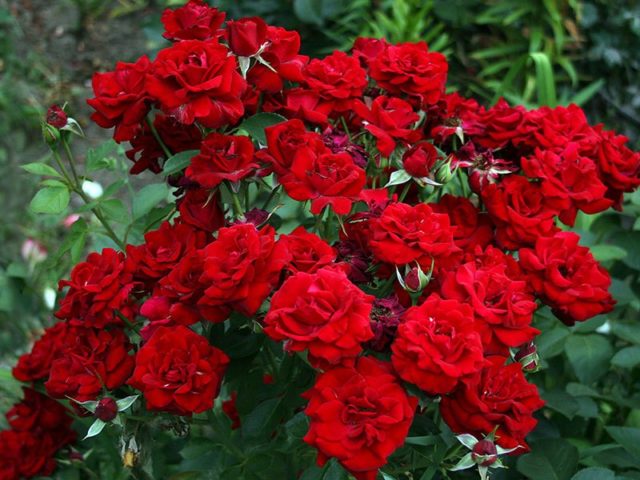
For abundant flowering, Niccolo Paganini roses are fed with potassium and nitrogen.
During the budding period, fertilizers are applied every 2-3 weeks. The last feeding is carried out in early September.
The soil around the bush needs to be cleared of weeds. Periodic loosening is recommended - at least once a month. At the same time, mulching is carried out.
Pruning is required twice a year. The first is spring, carried out to form a bush. The stems are cut lower by 3-4 buds to stimulate the growth of new shoots.In the fall, sanitary haircuts are carried out.
In the south and in the regions of the middle zone, covering roses is not required. In the Urals and Siberia, the Niccolo Paganini variety needs protection from frost. The plant is hilled up, and the surface shoots are covered with a breathable film.
Pests and diseases
The plant is susceptible to powdery mildew, rust, fusarium wilt and black rot. The appearance of such diseases affects the decorative qualities of the plant. When symptoms of the disease appear, it is necessary to remove the affected shoots. The plant is treated with a fungicide.
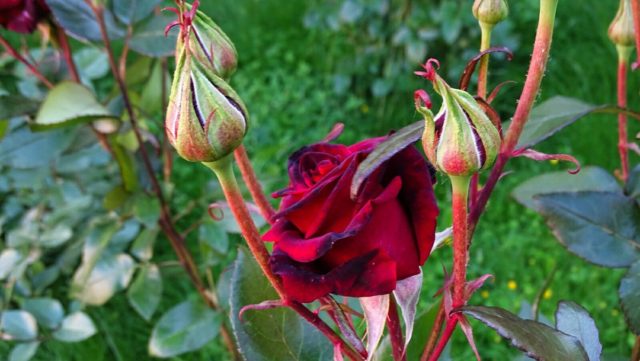
Premature wilting is the main symptom of the disease
Common pests include:
- aphid;
- spider mite;
- thrips;
- pennitsa.
To prevent insect damage, the plant must be sprayed with insecticides twice a year. For protective purposes, calendula and nettles can be planted next to rose bushes, which repel pests.
Application in landscape design
Niccolo Paganini roses are usually used for single plantings. Due to its demanding soil composition, the bush cannot be planted next to other long-flowering plants.
In flower arrangements, Niccolo Paganini roses should be given a central place. The variety is often used in alpine hills, placing undemanding low-growing plants around it.
Suitable neighbors:
- bells;
- hosts;
- cornflowers;
- Brunners;
- violets;
- lobelia;
- subulate phloxes.
The Niccolo Paganini variety should not be placed with tall shrubs. They will shade the rose, which will affect their development.
Conclusion
Rosa Niccolo Paganini is a floribunda variety that has earned wide popularity due to its decorative qualities.It is characterized by long flowering, high frost resistance and drought resistance. This rose is demanding on the composition of the soil, but is considered unpretentious in care. The plant will be an excellent decoration for any open area.
